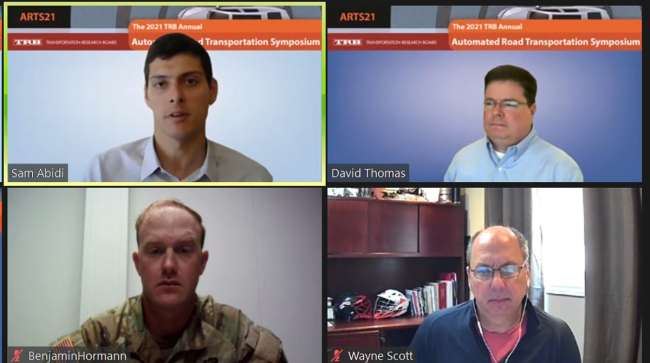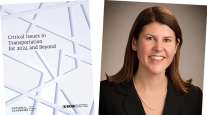Staff Reporter
TRB Panelists Talk Automated Trucking’s Implications on Driver Shortage, Safety

[Stay on top of transportation news: Get TTNews in your inbox.]
Automated trucking applications, particularly in the longhaul sector, have the potential to help alleviate some of the strains associated with the industrywide driver shortage, a panel of experts told researchers.
They addressed the Transportation Research Board’s Automated Road Transportation Symposium on July 12, following brief remarks from Federal Motor Carrier Safety Administration Deputy Administrator Meera Joshi who called highways “the perfect runways” for automated trucks.
David Thomas, senior manager of global supply chain network design and optimization at HP Inc., said the driver shortage is particularly prevalent in the longhaul sector.
Thomas added that autonomous vehicle technology is well-suited for trucks running on longhaul routes. Further, it would present an opportunity for truckers to operate closer to home. He participated in the panel discussion.

How do you care for your tires? Host Michael Freeze sets out to answer what factors fleets should consider when investing in TPMS and ATIS. He's joined by Matt Wilson of Hendrickson. Hear a snippet above, and get the full program by going to RoadSigns.TTNews.com.
“We’re always going to need drivers,” Thomas said. “It’ll keep them in that local, regional-type market so that they can be home either nightly or on a regular basis. I really see this as an opportunity to make the driving career more appealing because it’s taking away the area that people don’t want to do.”
American Trucking Associations estimates the industry will need to hire 1.1 million new drivers over the next decade to keep pace with freight transportation needs and retirements within the sector.
Sam Abidi, head of business development for Embark Trucks Inc., described the self-driving truck technology company’s use of the “transfer point model,” in which a human will pick up a load from a distribution center and take it to a highway-adjacent piece of land. Autonomous technology will take over for the longhaul portion of the drive, and another human will retrieve the load when it arrives at a highway-adjacent location near its destination.
Thomas noted there is a security benefit to hauling high-value products via autonomous vehicles, which don’t need to stop at rest areas and take breaks the way human drivers do.
Security benefits can extend to the people who are using these vehicles, too. (Joshi said 94% of crashes are due to human error.)
“Computers don’t get tired, they don’t get distracted, they’re not putting on makeup or eating a burger or drinking a coffee,” Thomas said. “They never look away.”
Maj. Benjamin Hormann, the science and technology project officer for emerging capabilities with the U.S. Army’s Expedient Leader Follower program, noted the importance of clear messaging for people sharing space with automated vehicles. Hormann said the vehicles in this program have mode indicator lights, which distinguish whether they are being operated by a person or a software system.
“I think there’s going to have to be a clear understanding and a clear common operating picture for all robotics systems that have certain mode indicator lights or something that’s indicating the fashion of that vehicle,” Hormann said. “There is heightened awareness when a vehicle is operating autonomously as opposed to having a driver in that vehicle.”

Joshi
From a federal perspective, Joshi said FMCSA will be pursuing the formulation of a safety regulatory framework for “an AV world” that will cover complex issues such as handling roadside inspections.
Joshi also emphasized the importance of training drivers on how to use vehicles equipped with advanced driver assistance systems.
“It’s this incremental shift, both in AV technology and in training, that allows us to prepare for the workforce of tomorrow without leaving anyone behind,” Joshi said.
Want more news? Listen to today's daily briefing below or go here for more info:




